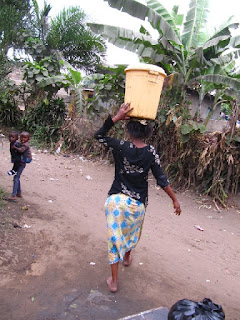THE RIDE
Leaving the city center could look like this bit of traffic in the Central Market.
All of these scenes are pretty common, traffic lanes indistinct, overloaded buses and trucks.
Markets all along the road with abundant produce and products and shoppers
Then we come to the roads less traveled by................still busy but in a different way.......
Sometimes a little precarious....................
We park the truck on a street similar to this and hike into the area where the wells are being dug.
THE HIKE
These roots make me wonder, do they grow like this? Or has the rain eroded the sand away from them?
 |
| Casava flour for making foofoo and other staples. |
Braiding hair, every day, adding extensions of varying colors and lengths.
Without Felix, we would still be wandering around on these trails, looking for the truck.
Elder Van tried to hitch a ride, but these kids weren't too sure they wanted more riders.
Maison a louer -- house for rent--we forgot to ask "How much?"
Playing with dolls. Creating a house with beds and rooms etc,-- it's pretty universal.
This tailor had created some amazing dresses!
This sweet lady put the tub on her head and then leaned down to pick up her bag without even losing the balance for a second.
This is the reason we are building wells-----these women and children spend a large part of their day walking and carrying water.
THE PROCESS
After the sites are selected, landowners committed, and materials carried into the area; the first step is making the cement rings. These forms are assembled and hand mixed cement poured into them. Each well needs 14 to 20 of these rings which are each 1 meter high and a meter in diameter.
 Masha, the engineer is cutting a mold in the sand for the primary ring which goes into the hole first. It is about 10 inches high, a bit wider than the others and pointed on the bottom.
Masha, the engineer is cutting a mold in the sand for the primary ring which goes into the hole first. It is about 10 inches high, a bit wider than the others and pointed on the bottom.
This shovel has a very short handle for manipulation inside the well.
When they have dug under the first ring enough that it sinks into the ground and is about ground level, they cement another on top.
It is dirty work, but they make it fun. They sing as they work and take time to dance with Elder Van.


He was wishing he had brought his gloves this day.
This worker would run from the well to the pile where he emptied the buckets
to keep the work moving.
They climb in and out using the sides of the well and the rope just for stability.
 |
| When the water level was reached, we could tell before we arrived --the path was running with gold water. |

The hole gets so deep, you can hear them say "Mbote Mama", but you can't see them down there.
When there are three rings below water level, it is finished. Gravel is filled in around the rings.

A temporary lid is poured in a sand form and placed on top to wait for the pump installation.
And the sides around the outside are built. There is no form used for this. Cinder blocks are placed and cement is filled in by hand. The man who did this was an artist. He made this with just a trowel and cement.
The pumps are installed and VIOLA! clean water! But we aren't there yet......................
The population is invited to hygiene classes where they are instructed in the reasons why clean water is worth paying for. Each person who attended received a booklet about hygiene, two bars of soap, a drink and a sweet roll. We hoped the word would get out and more would come the next time. We were right. The group increased from 50 to 85 in the three sessions.

A committee is elected from those in attendance and a closing ceremony is held.
When the ribbon is cut and the wells are given to the community, the people can come there for water. It is clean unlike other sources and much closer to their homes. The committee is then responsible to collect a nominal fee and maintain the wells and pumps.
The closing ceremony was held Sept. 15. Our departure date September 23. It was a photo finish!
We are really happy we had this great opportunity to serve the people of Africa.
Now Africa, a symbolic kiss goodbye!


















































